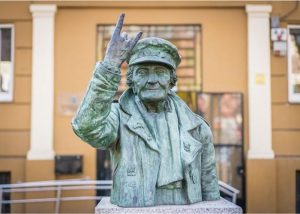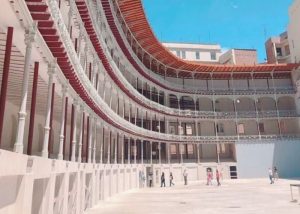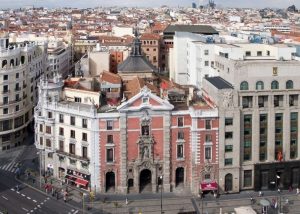The Spanish capital exists thanks to a peculiar decision of King Phillips II in 1561. He moved himself, including the entire court, from Toledo to Madrid. The King chose the many forests, springs, the eternal blue skies and the fertile fields around Madrid to feed the new townspeople.
The fact that Madrid is a relatively young city does not mean that its history has not left its mark. InSpain.news had a look and found five curious places to make the next trip to Madrid even more interesting.
The rocking grandmother
Calle de Peña Gorbea, metro stop Puente de Vallecas (Madrid East)

Despite being well into her eighties, Argentine-born, Spanish-adopted Angeles Rodriguez Hidalgo loved heavy metal rock music. So much so that she attended as many festivals and concerts as possible. She always dressed in a leather jacket and was somewhat the most loyal fan of AC / DC. Moreover, she conquered the hearts of the mostly younger hard rockers with her charisma and thus became a phenomenon in Madrid’s nightlife.
She knew so much about music that she got a column in “Heavy Rock” magazine entitled “Abuela Consulta” (roughly translated: grandma’s advice). After her death she was so terribly missed and therefore immediately became a legend. As such her fans wanted to make her even more immortal with a statue.
The artist Carmen Jorba captured “rock grandma” in bronze, complete with a leather jacket and cap. Also with her hand lifted in the sign of the “corna”. This is common in heavy metal circles; a fist with a little finger and index finger raised. Unfortunately, vandals broke these fingers off the statue, making the monument of the Abuela Rockera now more communist.
Fish farm in the middle of the Spanish capital
Calle de las Moreras, s / n, metro stop Ciudad Universitaria (Madrid West)
Unexpectedly, in the middle of the Spanish capital city, there is a fish farm between all the buildings. The fish in the Escuela de Ingenieros de Montes are bred purely for study and conservation purposes. The students, who graduate in bio-engineer forest and nature management, use it during their practicals. All fish species here, such as barbel, carp, eel and sturgeon, are native. However, the star of the installations is the trout that traditionally lived in the rivers around Madrid but is now endangered.
The water for the nursery comes from a well below the city that is 200 meters deep. The nursery is located in the middle of an arboretum with four hundred plant species that you can walk through. Once you have had enough of the fish and plants, the ground-floor building with an aquarium on the ground floor is also very worthwhile.
Remains Frontón Beti-Jai
C / Marqués de Riscal, 7, Rubén Darío metro stop (Madrid-North)

The title will ring a bell with few people. Sandwiched between the residential buildings of the last century in the district of Chamberí. You will find in this exclusive area of the Spanish capital of an impressive ruin. At first glance, it looks like a strange, slightly circular building. Behind the facade is a rectangular vacant field. This 4,000 square metre “frontón” was built in the nineteenth century to meet the massive interest in the then super popular Basque football (pelota Vasca).
Frontón means covered area and the name of this frontón was “Beti-Jai”, which in Euskadi or Basque means “always party”. Beti-Jai was designed by the architect Juaquín Rucoba on behalf of entrepreneur José Arana. Arana wanted his frontón in the same style as the one in San Sebastián, but better, bigger and made of more modern materials.
It was opened in April 1894. The Madrid bourgeois made good use of it for years. These heydays lasted only 16 years. Beti Jai was closed in 1919. Initially, the field served during the dictatorship and the years after as a police station and base for the music band of the nationalist party Falange. After that it was a Citroën garage for years.
Fortunately, the former government of Madrid turned it into a national monument instead of breaking it down to make place for luxurious and lucrative apartment blocks. It’s now restored to all its glory. The townhall organizes guided visits.
The spirit in love in the San José church
C / Alcalá, 43, metro stop Sevilla (Center East)
For lovers of ghosts and haunted houses, the Church of San José is a popular destination. When the nuns were expelled from the Carmelite monastery belonging to the church in 1836, the buildings fell into disrepair.

Until something crazy happened: a young man went out to dance on New Year’s night in one of the noble city palaces. He was bored until exactly at three in the morning the most beautiful girl he had ever seen came in. They spent the rest of the night together until dawn and she told him to go home. They walked hand in hand through the twilight streets of Madrid until the girl stopped at the San Jose church and said “I will stay here.”
The boy thought she was mistaken, but when she persisted, he felt fooled and left. The next day he walked past the church in the afternoon and saw that a funeral service was being held. Curious, he went in to see who had died. His surprise and shock couldn’t be greater when he saw his new lover lying in the coffin.
Blinded with grief, he ran out of the church and was followed by a girl who asked him what was wrong. Her response to his story was, “That was my niece. She has always been in love with you, but was too shy to approach you. She passed away last night at 3 am. ”
Image “Air crash”
C / Milaneses, 3, metro stop Opera (Centre West)
Sometimes it pays to look up while walking through strange places instead of straight ahead or to the ground. Similarly in Madrid. Numerous ornaments, statues and other details adorn the often stately buildings. In C / Milaneses around the corner from Calle Mayor, there is something special to see high above the bustling Spanish capital in the historic centre.
It looks like a fallen angel. A literally crashed man with enormous wings encased in a 300 kilo bronze statue with copper cover is a very disturbing sight and not only because he seems to fall from his place at any moment.
The statue, reminiscent of Lucifer or Icarus with its burnt wings, was created by the artist Miguel Angel Ruiz. Since 2005, this has graced the building at the request of the residents of the property who wanted something to decorate it.
According to Ruiz, the statue depicts a man who went for a walk 10,000 years ago and decided to return flying on his back. Floating through the air, playing with the clouds and enjoying the sun, he forgot the time to discover to his horror that an entire city had arisen in the pastures of yesteryear.
Related post: Parque Retiro – a green oasis in Madrid


